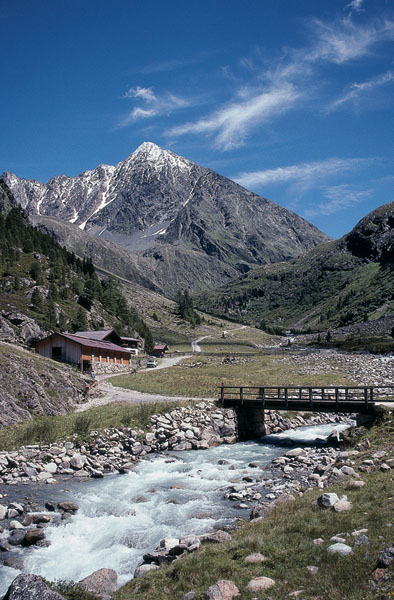
Lichen patterned rocks brighten many trails
| Start | Langtalereck Hut (2430m) |
| Valley base | Obergurgl |
| Distance | 3km |
| Height gain | 429m |
| Height loss | 83m |
| Grade | 3 |
| Time | 2hrs |
| Location | South of the Langtalereck Hut |
Like the Langtalereck Hut, the Hochwilde Haus is owned by the Karlsruhe section of the DAV, and has an outstanding location overlooking the Gurgler Ferner from the well-named Steinerner Tisch (Stone Table) below the Schwärzenkamm ridge. A small pool lies beside it. The hut is unquestionably a magnificent place in which to spend the night, whether or not you have plans to climb any of the peaks above it.
From the Langtalereck Hut take the path directly ahead and branch right when it forks shortly after. It now descends frustratingly into the narrow ravine-like Langental to cross the glacial stream flowing through it. Across this the path now climbs the steep and in places exposed northern end of the Schwärzenkamm ridge – a fixed cable safeguards the most exposed section.
After turning the Schwärzenkamm spur the gradient slackens as the outlook grows in drama, and you rise along the lateral moraine wall to reach the group of four buildings that includes the Hochwilde Haus. Allow 3–3½hrs for the return to Obergurgl.
Built in 1938–39 the Hochwilde Haus (2866m) enjoys a wonderful vista of mountain and glacier from its platform of stone. It has 30 beds and 60 dormitory places, and is manned from the end of June to mid-September (tel 0664 4245824).
Cutting into the mountains south-west of Zwieselstein, the Ventertal is a sparsely-populated valley whose only real village, and that a very small one, is Vent at 1896m. The village has a modest amount of hotel accommodation and limited shopping facilities, but makes a good walking centre (www.vent.at). The valley forks just beyond Vent, with the Niedertal extending to the south, and the Rofental to the west. A steep road climbs briefly into the latter valley to reach the hamlet of Rofenhöfe (2014m), with footpaths that continue from it.

Lichen patterned rocks brighten many trails
In September 1991 two German walkers discovered a body protruding from the Similaun glacier. Although it was found on the Italian side of the border, the corpse was removed from the ice and taken to Innsbruck University for examination. At first thought to be a walker who’d perished after being overtaken by a storm, speculation then focused on a Viennese music professor who had disappeared in 1939. However, carbon dating later revealed the body to be around 5500 years old! The tools and clothing found with him confirmed that Ötzi belonged to the late Stone Age, his diet consisting of ibex meat and cereals. He would have weighed around 45kgs, and died at the age of about 45. With worldwide interest aroused, Ötzi became the subject of an ownership dispute between the Austrian and Italian authorities, but since it was proven that the body was found 90m inside the Italian border, he was eventually taken to the Museo Archeologico in Bolzano where he has become the prize attraction. Not to be outdone, at Umhausen in the lower Ötztal, there’s now an ‘Ötzi Dorf’ – a replica village based on Ötzi’s period in history.

The lovely Sulztal on the way to the Amberger Hut